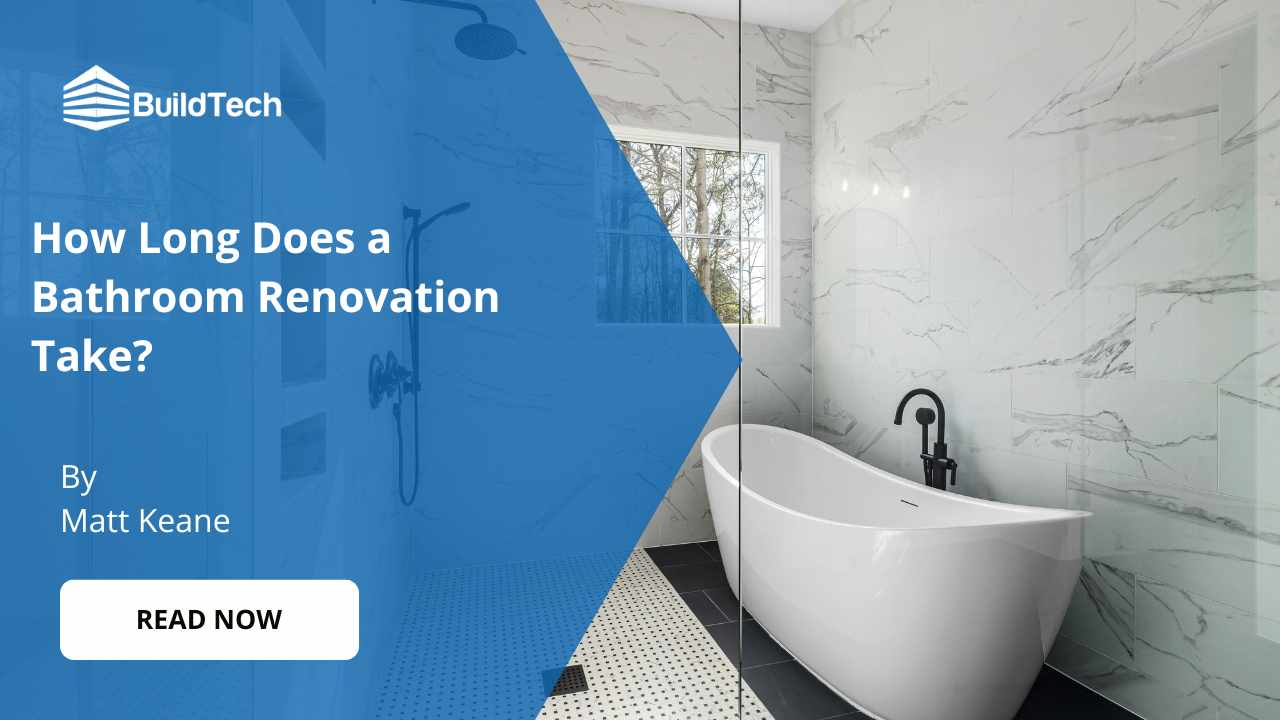Ever felt a bit unsure about updating your bathroom? Lots of homeowners in Ireland have struggled with planning their bathroom makeover, from setting a budget for new tiles to picking out the right kind of shower.
We fully understand this, staring at old tiles and fittings and wanting a modern, calm space. Here's a key tip: having a clear budget for your bathroom update is really important.
In this guide, we'll help you through every part of changing your bathroom; it's like your personal guide, from removing old walls to adding those elegant final touches.
Be prepared for insightful tips. As we progress step by step, what may have seemed complex will become effortlessly manageable, perhaps even more quickly than your shower reaching the ideal temperature! Stay engaged; let’s collaboratively build your perfect bathroom. So, stick with us; let's work on making your dream bathroom a reality!
Assess Your Bathroom Requirements
Before diving into the renovation process, it's important to assess your bathroom's requirements. Determine your budget, choose a design that suits your style, and identify the necessary fixtures needed for your new and improved space.
This step will lay the foundation for a successful bathroom remodel.
Determine budget
We all like to know how much cash we'll need for a job, right? So figuring out our budget comes first. We want to see how much we can spend without breaking the bank. This includes everything from shiny new taps to the paint on the walls.
It's smart to have an extra bit just in case something surprising pops up. After all, it’s better to be ready than sorry when we start knocking down walls and changing pipes.
Setting this money aside helps us stay on track and avoid overspending. Plus, if we find deals or ways to save some coins during our bathroom makeover, that's more money for other fun stuff around the house! It feels good knowing exactly what we can afford as we create a fresh new look for our bathroom.
Choose design
Before starting your bathroom remodel, we should consider the design carefully. This includes deciding on the style, colour scheme, and layout of your new bathroom. Keep in mind that the design should complement the overall look of your home while also meeting your practical needs.
For instance, if you have a small bathroom, choosing light colours and minimalistic fixtures can make it feel more spacious. Additionally, selecting water-resistant materials is crucial to preventing damage in wet areas.
Take inspiration from various sources, such as home decor magazines or online platforms, to gather ideas that resonate with you. It's essential to choose a design that not only looks good but also functions well for you and your family.
Identify necessary fixtures
To start our bathroom remodel, we need to identify the fixtures we want to replace or add. This includes choosing a new shower or tub, selecting flooring materials, and deciding on wall coverings.
It's important to consider the design and functionality of each fixture to ensure they meet our needs and fit within our budget. In addition, we should also plan for installing sanitary ware such as sinks and toilets.
Once we have a clear idea of the fixtures needed for the remodel, we can move on to the next step of dismantling the old bathroom.
Removal of Old Bathroom
After assessing your bathroom requirements and choosing the design, it's time to remove the old bathroom. This involves the demolition of fixtures and tiles, the disconnection of plumbing, and the removal of flooring and wall coverings before moving on to the installation stage.
Demolition of fixtures and tiles
It's important to carefully remove old fixtures and tiles when remodelling a bathroom. This step should be conducted with caution to avoid damage to surrounding areas. Here are the detailed steps for demolishing fixtures and tiles:
- Turn off the water supply and disconnect all plumbing connections to the fixtures.
- Begin by removing the bathroom fixtures, such as the sink, toilet, and bathtub/shower.
- Use appropriate tools to carefully dismantle the tiles from the walls and floor.
- Dispose of old fixtures and tiles responsibly, ensuring compliance with local waste disposal regulations.
Disconnection of plumbing
When removing fixtures and tiles, it's essential to disconnect the plumbing to ensure a smooth and safe demolition. Here are the steps to disconnect plumbing during your bathroom remodelling project:
- Turn off the main water supply to the bathroom.
- Use a wrench to disconnect the water supply lines from the sink, toilet, and shower or tub.
- Drain any remaining water in the pipes by turning on the faucets after shutting off the water supply.
- Disconnect the drain lines from the sink, shower or tub, and toilet.
- Safely remove any exposed electrical wires that may be near plumbing fixtures.
Removal of flooring and wall coverings
After the disconnection of the plumbing, the next step involves removing the flooring and wall coverings. This process is crucial in preparing the space for new installations and creating a clean canvas for your bathroom remodel. Here's how to go about it:
- Begin by carefully removing the existing flooring material, whether it's tiles, vinyl, or laminate. Use appropriate tools to avoid damaging the subfloor.
- Once the flooring is removed, focus on detaching the wall coverings, such as tiles or wallpaper. Take your time to ensure that the walls are not damaged in the process.
- Clean the surfaces thoroughly to remove any adhesive residue or debris left behind from the removal process.
- Inspect the subfloor and walls for any signs of damage or moisture issues that may need to be addressed before installing new materials.
- Consider making any necessary repairs or adjustments to ensure that the new flooring and wall coverings will have a solid and level foundation.
- Plan for proper disposal of the old flooring and wall materials, following local waste disposal regulations, and considering environmentally friendly options if possible.
- Once everything is cleared out, you're ready for the exciting part: installing new flooring and wall coverings that will bring your bathroom remodel to life!
Bathroom Installation
Bathroom installation requires installing new fixtures, laying new flooring, hanging drywall and paint, adding lighting and ventilation, and connecting the plumbing. Want to know more about the process of remodelling a bathroom? Keep reading!
Install new fixtures
Let's talk about installing new fixtures in your bathroom. Here are the steps you need to follow:
- Fit the new sink and attach the taps securely.
- Install the toilet and ensure it is properly sealed to prevent leaks.
- Place the new bathtub or shower unit, and connect the plumbing.
- Attach the towel bars, toilet paper holder, and any other accessories securely.
Lay new flooring
Start by choosing the type of flooring we want in the bathroom. It's important to consider materials that are suitable for wet areas and easy to maintain. Here are the steps involved in laying new flooring:
- Remove the old flooring carefully to avoid damage to the subfloor.
- Prepare the subfloor by ensuring it is clean, level, and dry.
- Measure and cut the new flooring material according to the dimensions of the bathroom.
- Lay the flooring, starting from one corner and working towards the opposite wall, ensuring a snug fit.
- Use adhesive or secure the flooring following the manufacturer's instructions to ensure it stays in place.
- Finish by sealing any gaps or edges for a polished look.
Hang drywall and paint
Once the fixtures and plumbing are in place, we can proceed with hanging drywall and painting to give the bathroom a fresh look. Here's what you need to do:
- Measure and cut the drywall to fit the bathroom walls, making sure to leave space for electrical outlets and switches.
- Secure the drywall to the wall studs using screws, ensuring it is even and flush against the wall.
- Apply joint compound to cover the seams between drywall panels, smoothing them out with a trowel for a seamless finish.
- Sand down any rough areas on the dried joint compound, then apply a primer coat before painting.
- Choose a paint colour that complements your bathroom design, and apply two coats evenly for a professional look.
Install lighting and ventilation
After the completion of hanging drywall and painting, the next step in remodelling your bathroom is to install lighting and ventilation. This will ensure a well-lit and properly ventilated space for your comfort and convenience.
- Lighting: Consider installing overhead lighting for general illumination, task lighting near the vanity for grooming, and accent lighting to highlight certain features.
- Ventilation: Proper ventilation is important to prevent mould and mildew. Install a vent fan to improve air quality and reduce moisture buildup.
- Switches and Controls: Position light switches at convenient locations with easy reach from the entrance. Similarly, place the ventilation controls where they can be easily accessed.
- Waterproofing: Ensure that all electrical components are waterproofed to prevent damage from humidity or water exposure.
- Energy Efficiency: Choose energy-efficient lighting fixtures and ventilation fans to reduce energy consumption and lower utility bills.
- Natural Light: If possible, consider adding windows or skylights to bring in natural light, which can enhance the ambiance of the bathroom.
- Safety Considerations: Install GFCI outlets near water sources and choose lighting fixtures rated for bathroom use to ensure safety compliance.
- Professional Assistance: For electrical work or complex installations, it's advisable to seek professional help to ensure compliance with regulations and safety standards.
Connect plumbing
When the bathroom installation is underway, connecting the plumbing is a crucial step that ensures everything runs smoothly in your new space. Here's how to effectively connect the plumbing in your renovated bathroom:
- Ensure that all new fixtures, such as sinks, toilets, and showers, are properly connected to the existing plumbing system. This includes sealing connections and checking for any leaks.
- Test the water flow and drainage of all newly installed fixtures to guarantee proper functionality.
- If any adjustments are needed, make sure to address them promptly before moving forward with further installations or finishing touches.
- Consider consulting a professional plumber if you are unsure about any aspects of connecting the plumbing, especially when dealing with more complex systems or layouts.
- Adhere to local building codes and regulations regarding plumbing connections to ensure compliance with safety and quality standards.
Finishing Touches
We'll add the final decorative elements, give the bathroom a thorough clean-up, and then assess our completed project. Ready to see the amazing transformation? Read on!
Decorative elements
Let's talk about adding decorative elements to your renovated bathroom. Once the fixtures and essentials are in place, it's time to add those finishing touches that make the space feel like home.
Consider adding elements such as towel racks, a stylish mirror, and coordinating accessories like soap dishes or jars for cotton balls. Additionally, a pop of colour through towels or artwork can bring personality to the room.
Remember that small details can make a big difference in how the final result looks and feels.
While adding decorative elements, keep in mind that simplicity often works best. Avoid cluttering the space with too many decorations, as this can make the room feel smaller and less relaxing.
Final clean-up
After completing the remodelling work, we need to focus on the final clean-up. This involves removing any construction debris, such as packaging materials, leftover tiles, and old fixtures.
We can also sweep and mop the floors to remove any dust or dirt that may have accumulated during the renovation process. Additionally, wiping down all surfaces, including countertops, cabinets, and mirrors, will give our newly renovated bathroom a sparkling finish.
It's important to ensure the space is clean and tidy before adding decorative elements or using the new fixtures.
Assessment of completed project
After completing the bathroom remodel, we need to carefully assess the finished project. This involves checking if all the fixtures and fittings have been installed correctly, ensuring that the plumbing and electrical work are functioning properly, and inspecting for any potential issues or defects.
It's essential to assess if the new design meets our expectations and if it has improved both the functionality and aesthetic appeal of our bathroom. After this thorough assessment, we can confidently move forward with enjoying our newly renovated space.
Final Words
Remodelling a bathroom should begin with assessing the requirements and setting a budget. Removing the old fixtures and disconnecting the plumbing comes next for an efficient process.
Then, installing new fixtures, laying flooring, painting, and adding final touches bring the project to completion. It's practical to renovate in stages for flexibility and efficiency throughout the process.
Emphasising the importance of planning and following a clear timeline ensures successful bathroom remodelling projects. Remember that careful consideration of each step leads to impactful improvements in your home environment. For expert guidance and assistance in managing your bathroom remodel efficiently, consider reaching out to BuildTech. Their professional team can provide invaluable support and expertise to ensure your project is a success.


















